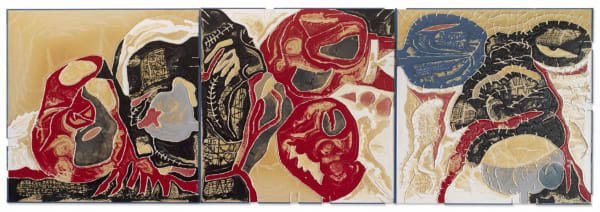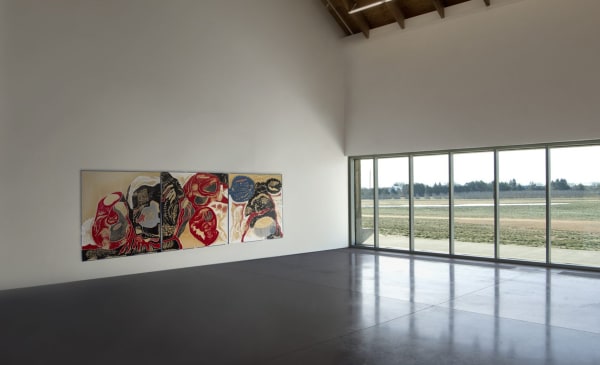In the 1950s art critic Harold Rosenberg coined the term “action painting” to describe the work of the Abstract Expressionists, confirming that a painting was not just a surface on which to paint a picture but one on which to record an event or “action.” The painter Willem de Kooning expanded on Rosenberg’s idea by declaring that the canvas, where the act of painting took place, was the “arena” in which an artist acts. In a series of 15 monumental paintings (the number of works corresponds to the number of rounds in a championship prizefight), the artist Joe Zucker picks up on the idea of struggle, dominance, and survival in the art world and extends de Kooning’s arena to the domain of boxing. Titled Combinations—a nod to the specific sequence of a fighter’s movements, like a right jab followed by a left hook—the complete work was first shown in 1981 at the Holly Solomon Gallery in New York.
The paintings on view here, Boxing Rounds #13, #14, and #15 (1981), delineate the finish of the prizefight: the last uppercut of the red boxing glove before the boxer drops to the “canvas;” the cotton strips suturing the bruise-blue and blood-red gashes; the bands that “frame” the painting like ropes around a boxing ring and here do double duty as they channel the flowing liquid poured directly from the can onto the flat canvas in shapes that, as the artist has noted, “no human hand could make.” If de Kooning marked the canvas as the “arena of the action,” Zucker has confounded all expectations for the resulting combat. Making a painting “by pouring paint from a can,” he once wryly observed, “is like painting with boxing gloves on.”
Zucker grew up in Chicago, home to legendary prizefights like Jake “Raging Bull” LaMotta vs. Sugar Ray Robinson at Chicago Stadium in 1951. He also grew up roaming the halls of the Art Institute, taking Saturday classes as a young boy, later earning both undergraduate and graduate degrees from the School of the Art Institute of Chicago. “I spent a lot of time looking at all the great paintings in the museum . . .Van Gogh’s Bedroom in Arles, Seurat’s La Grande Jatte, and of course de Kooning’s masterpiece, Excavation.” But like most young artists, Zucker soon realized that he had to have ideas of his own. “One day I was standing in my studio,” he recalled, “and I couldn’t figure out what to put on the canvas, so I decided I would paint a picture of the canvas. I would reduce it to the subject of how canvas is made, and it was going to be reductive in a way that had to do with the material construction.” This became Zucker’s approach in an ongoing artistic inquiry into the physical properties of painting and, in a career of over fifty years, he rarely repeated a method, from paint-soaked cotton balls to deconstructed grids.
August 20, 2019


